Everything We Learned about AWS Marketplace & Partner Programs at AWS re:Invent 2020
For those of you familiar with Tackle, you know we love to share the latest news about the Marketplace from many different perspectives. Well, this is no different, with our collective take on the top announcements during re:Invent week one, from a Marketplace and Partner perspective.
Here’s what we found to be the most interesting and relevant for any ISV Partner or AWS Marketplace participant.
Andy Jassy’s 2020 re:Invent Keynote
Andy Jassy, CEO of Amazon Web Services, kicked off AWS re:Invent 2020 on December 1st by addressing the industry’s latest trends and challenges, centered around the theme of speed, innovation, and the willingness to always reinvent oneself. This year re:Invent is unlike any other year because of the pandemic and in an attempt to adapt AWS had to reinvent the event and make it 100% digital.
In the first week of AWS re:Invent we saw over 30 announcements of product launches and major features. Ranging from databases to cloud compute, and from hybrid solutions to containers, there was a lot to digest. Nevertheless, the theme remained the same—driving a culture of reinvention. In his almost 3 hour-long keynote, Andy Jassy suggested that in order for businesses to not only survive but to thrive, management needed to continuously find ways to reinvent themselves. Throughout the keynote, he highlighted the 8 keys to reinvention:
- Leadership’s will to invent and reinvent
- Acknowledgement that you can’t fight gravity
- Talent that’s hungry to invent
- Solve real customer problems
- Speed
- Don’t “complexify”
- Use the platform with the broadest and deepest set of tools
- Pull everything together with aggressive top-down goals
If you net these key messages, it boils down to the speed of execution, simplicity, customer problems with an undertone of challenges inherent in any organizational change. We believe AWS Marketplace provides the avenue or channel to facilitate many of these initiatives; but a lot of the heavy lifting must be done by leadership to enforce aggressive goals, governance, and accountability.
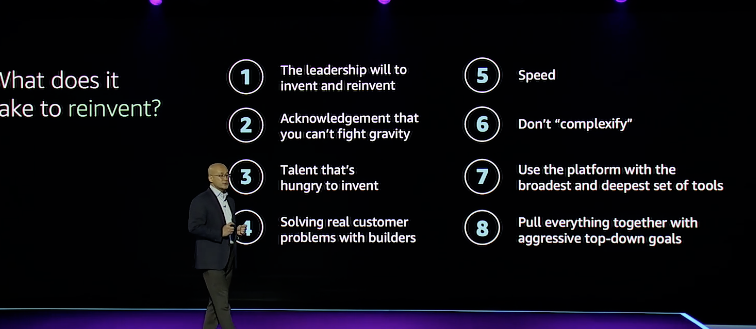
We were hoping to hear something specifically related to AWS Marketplace in the opening keynote, but nothing caught our ear. However, no big deal as plenty of Marketplace discussion occurred in following sessions.
Week 1: AWS Marketplace News from AWS re:Invent 2020
Dave McCann, VP of AWS Migration, Marketplace, and Control Services, had a busy week, participating in the Thursday Keynote session while also spearheading a session of his own. He outlined how AWS is continuing it’s trend as the premier innovator of Cloud Marketplaces by showing this graphic of top AWS Marketplace announcements over the past 8 years.
While a number of announcements were made last week relating to AWS Marketplace, we found the following four to be our top picks (see link at the end for information about the broader set of announcements).
But, before we run through these top announcements, let’s first recap an interview that Dave had with Paul von Autenried, Executive Vice President and Chief Information Officer at Bristol Myers Squibb. Paul went through the 10+ year journey with AWS, but also commented on his top “wish” for the future. His answer echoed the sentiment of many large ISVs and enterprise buyers we engage with: frictionless experience across multiple clouds.
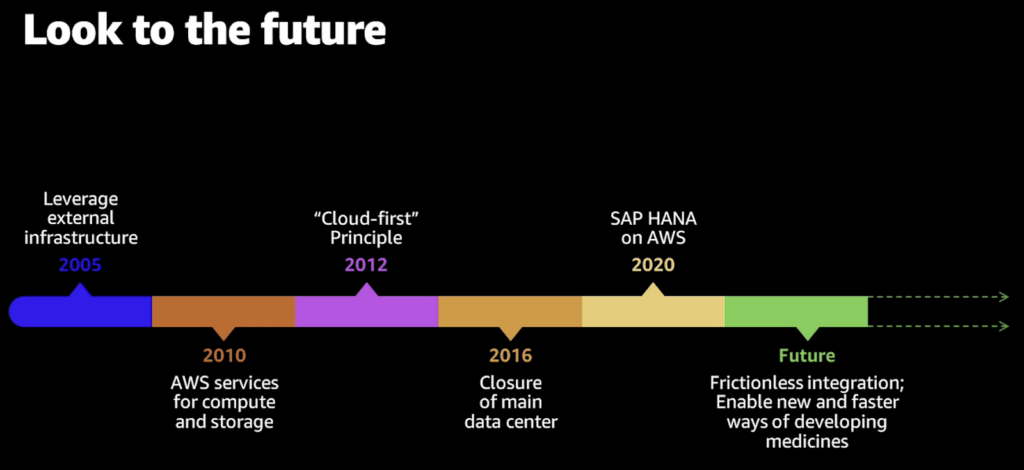
“Our world today is characterized by many clouds. I’m pretty sure when clouds collide they create thunder and lightning, so pretty high on our wish list is a greater method of frictionless integration across clouds.”
Announcement: Managed entitlements for AWS Marketplace
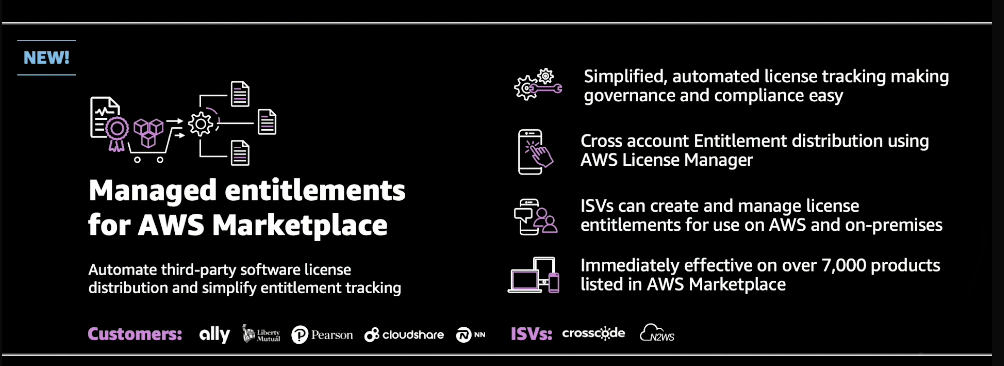
The exciting part about the announcement of managed entitlements is that it allows customers to better manage software licenses from different vendors across the infrastructure estate: AWS and on-premises environments.
This new feature requires a bit of “assembly,” as an ISV will need to associate subscriptions purchased through AWS Marketplace with granted licenses in AWS License Manager. Each time a customer purchases from AWS Marketplace, the license is activated based on AWS IAM credentials.
This blog by AWS does a great job of describing the features and high-level considerations.
Announcement: Private Marketplace APIs
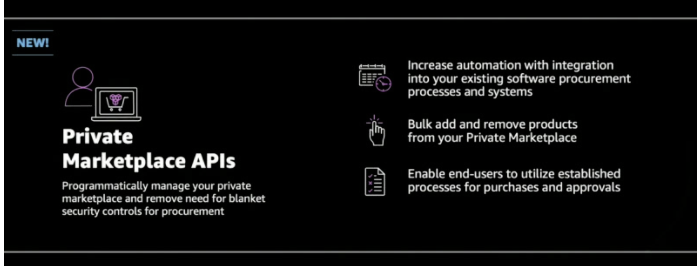
While AWS Private Marketplace was first announced two years ago, AWS is now making the API’s available for buyers to programmatically manage their AWS Private Marketplace. This step makes it easier to manage the security, governance, and visibility into the curated list of sanctioned first and third-party software made available in the Private Marketplace.
We see this as a logical advancement of this program, which we understand is gaining traction with large enterprises around the world.
For more details, check out the AWS blog here.
Announcement: AWS Service Catalog AppRegistry
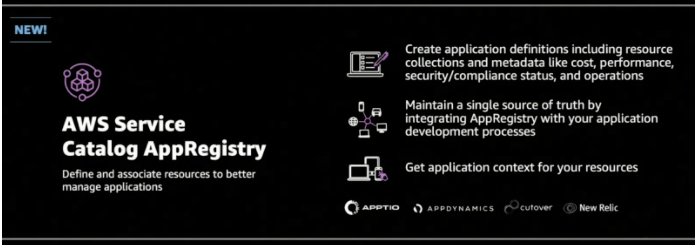
Customers building with first and third party services can now combine those transactions into a single quote and purchase through AWS Marketplace, making the entire process much faster and a heck of a lot more convenient.
Review more details in this AWS article here.
Announcement: Professional Services available in AWS Marketplace
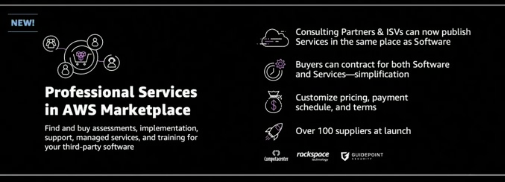
Many of our 250+ customers require implementation or consulting services in order to get their offering up-and-running in a customer’s environment. Historically, these services had to be contracted outside of AWS Marketplace, creating friction in the buying process because the end customer would go to AWS Marketplace to purchase the software then go directly (or to another source) to find a services offering.
This announcement marks the first hyper-scale Cloud Marketplace that offers the purchase of professional services, a step we believe will swiftly remove friction in the buying and onboarding process. McCann noted that over 100 professional services offerings are already available to transact through AWS Marketplace.
AWS wrote a great summary about this announcement, outlining benefits to both buyers and sellers. Check that blog out here.
For the entire list, see all of the top new announcements here as well as some individual blog posts here.
Week 1: AWS Partner Program News from re:Invent 2020
On day four of AWS re:Invent, Doug Yuem, Head of AWS’ Global Partner Organization, took the stage for the Partner Summit Keynote with Sandy Carter (Vice President of Global Public Sector Partners & Programs) and Dave McCann (Vice President of AWS Migration, Marketplace, and Control Services) to discuss all things partnership related.
Like Andy Jassy’s keynote, the theme for the Partner Summit was centered around speed and agility that partners need in order to reinvent themselves to weather the pandemic and deliver on the demands and needs of their customers. A bevy of partner offerings and initiatives were announced in order to help partners meet the demands and needs of their customers:
- AWS Energy Competency (2021): Program that recognizes best-in-class AWS Partners who support energy customers and have completed technical validation with AWS.
- AWS ISV Partner Path (2021): Eliminates partner-level badging to solution-level badging to better align with customers’ needs. The new experience is designed to accelerate the engagement that independent software vendors (ISVs) have with AWS, through prescriptive guidance, curated programs, funding benefits, and co-selling support.
- AWS Mainframe Migration Competency (2021): A new category within the AWS Migration Competency Program that recognizes AWS Consulting and Technology Partners for expertise in mainframe migrations.
- AWS Public Safety and Disaster Response Competency: A new track within AWS Public Safety and Disaster Competency for AWS Technology Partners that help customers improve organizational capacity to prepare, respond, and recover from emergencies and disasters.
- Amazon RDS Service Delivery Program: Designed to help customers identify AWS partners with specific database engine expertise to set up, operate, and scale relational databases in the cloud.
- AWS SaaS Boost (preview): Open source ready-to-use reference environment that enables Independent Software Vendors (ISVs) to accelerate the move to Software-as-a-Service (SaaS).
- AWS Travel and Hospitality Competency: New competency focused on travel and hospitality, including 27 AWS Consulting and AWS Technology Partners from around the world.
Week 2: Machine Learning Keynote
This was the first time ever that AWS hosted a Machine Learning keynote at re:Invent. Swami Sivasubramanian, VP of Amazon Machine Learning, took the stage to discuss the latest technologies and developments in machine learning at AWS. To start, Swami noted that Machine Learning was no longer a speculative, niche solution based in the future but actually a very real solution being utilized by more than 100,000 AWS customers like Nike, BMW, and Domino’s.
A primary focus during the keynote was the idea of providing customers and developers with the “freedom to invent” and innovate faster with AWS’ Machine Learning solutions. In keeping with this initiative, AWS has released more than 250 new machine learning and A.I. features in the last year alone.
Week 2: Infrastructure Keynote
In this keynote from Peter DeSantis’, SVP of Global Infrastructure and Customer Support, there was a focus on efforts in improving resilience, availability, and sustainability for AWS customers and partners. An interesting thought that Peter referenced during the presentation was the notion that “Everything fails.” As such, it is important to anticipate failure and build products and solutions that are designed to protect customers from those failures.
Peter announced that AWS was taking measures to protect their customers by replacing central Uninterruptible Power Supplies (UPSs) with “Micro UPSs.” Doing so increases the number of regions and availability zones, and thereby optimizes efficiency and performance. To further improve availability and reduce latency, AWS will continue to invest in more regions and Availability Zones (AZs) globally. On the horizon are India, Indonesia, Japan, Melbourne, Spain, and Switzerland. More about AWS’ infrastructure can be found here.
Week 2: Marketplace Sessions
We won’t be getting into every single session here, but one session we found particularly interesting was How to Sell on AWS Marketplace hosted by Chris Grusz, Director of Business Development (AWS Marketplace), which covered how to sell on AWS Marketplace and best practices.
Since AWS launched the Marketplace just 5 years ago, it has grown to over 8,000 listings and 1,600 sellers, with over 1,000 of those sellers being ISVs. Chris explained the AWS Marketplace is really a curated digital software catalog that helps customers find, test, buy, and provision software and data products. In other words, it acts as an end-to-end supply chain that helps customers get 3rd party software into their environments.
Chris continued to discuss why ISVs should sell on AWS Marketplace. He highlighted three key reasons:
- Customers wants a streamlined procurement process
- Sellers can leverage AWS to grow their customer base
- Fast sales cycles and efficient provisioning lead to overall higher profitability
Additionally, he mentioned that it wasn’t enough to just get listed, sellers need to drive attention and awareness to their marketplace listings. We couldn’t agree more! Fortunately, AWS has many GTM programs that are designed to help sellers do just that. Demand Generation, Managed Seller GTM, APN Marketing Concierge, and Seller GTM Academy are GTM programs that are available globally to AWS Marketplace sellers.
That’s the high-level overview of the session, but there is a lot more great information in Chris’ session such as information about a Marketplace Portal, standardized license terms, accessing channel partners, and more that we haven’t covered here. If you missed it, check out the session to learn more—there is a lot in there that is useful for Tackle customers!
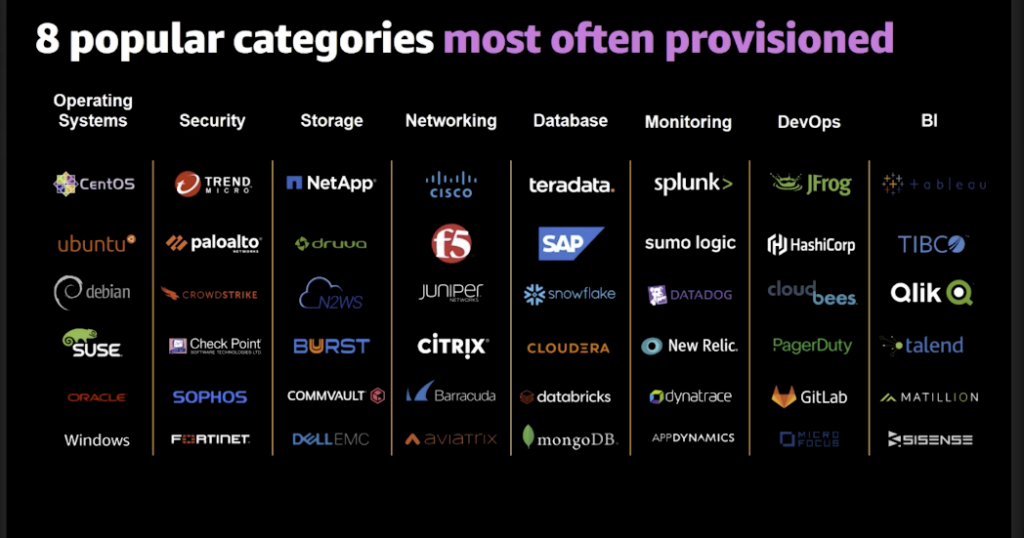
Accelerating Startup Success with AWS Marketplace was another great session that covered how startups are using AWS Marketplace to drive meaningful co-sell opportunities with AWS customers. In this session, Louise Strandoo (Startup BD Manager, AWS Marketplace), David Swanson (District Manager, Startups AWS), and Bill Lapcevic (VP of Business Development, Auth0) talk about their experiences and best practices for leveraging AWS Marketplace.
There was a lot covered in the session but there were items worth highlighting and remembering. In order to have success with the AWS Marketplace there are three things that startups and ISVs should keep in mind:
- It’s important to remember what’s important to which audiences
- Driving success on AWS Marketplace starts with a place
- AWS Marketplace can shorten sales cycles and help gain visibility with AWS field teams
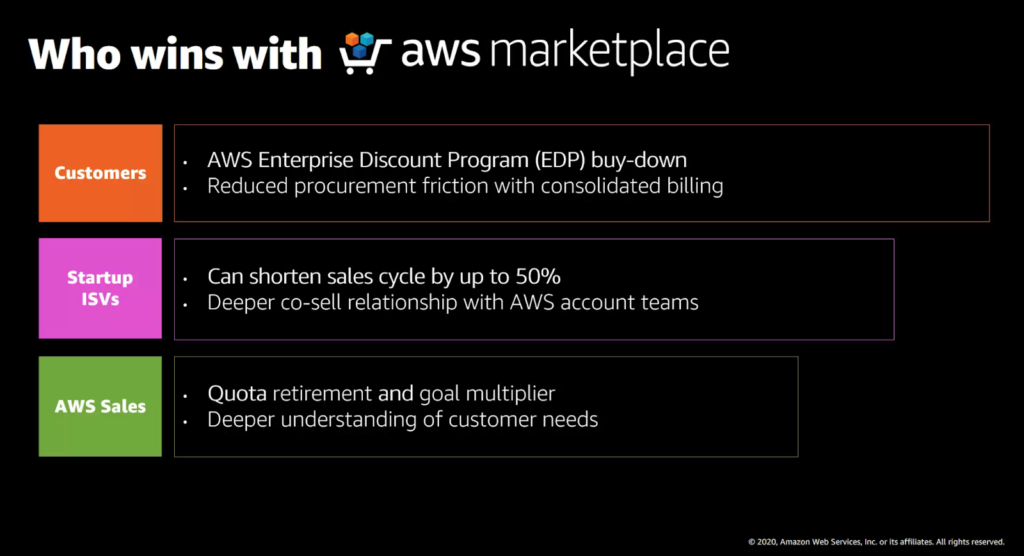
The graphic above answers the first bullet point perfectly. It outlines the different audiences that are involved with the AWS Marketplace and what motivates each group. Keeping these things in mind will help when trying to solve for the second point, which is to develop a plan. A well thought-out plan involving all three of the groups mentioned above should always involve three stages: Build, Market, and Sell. A good example of this might look like this:
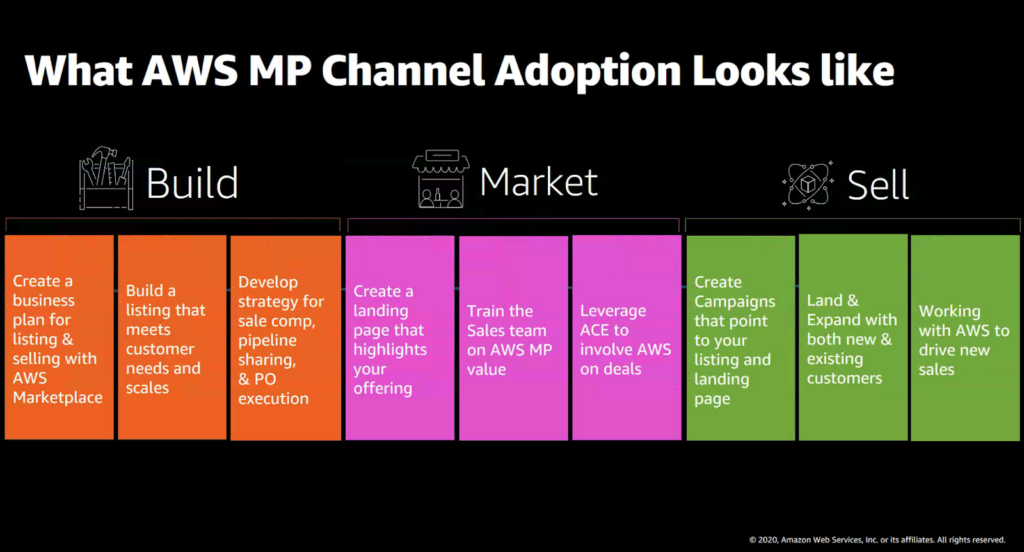
The ultimate goal of any partner operating in the AWS Marketplace is to drive channel adoption and scale their Marketplace strategy into a viable channel of revenue. The team talked a bit about the best practices that they have seen or employed to do accelerating success through AWS Marketplace. The first thing the AWS team mentioned was to invest in your strategy and to have a team and partners that you trust to help scale i. The AWS team and Auth0 even gave a nice shout out to Tackle as a trusted partner to help manage and scale Marketplace strategies.
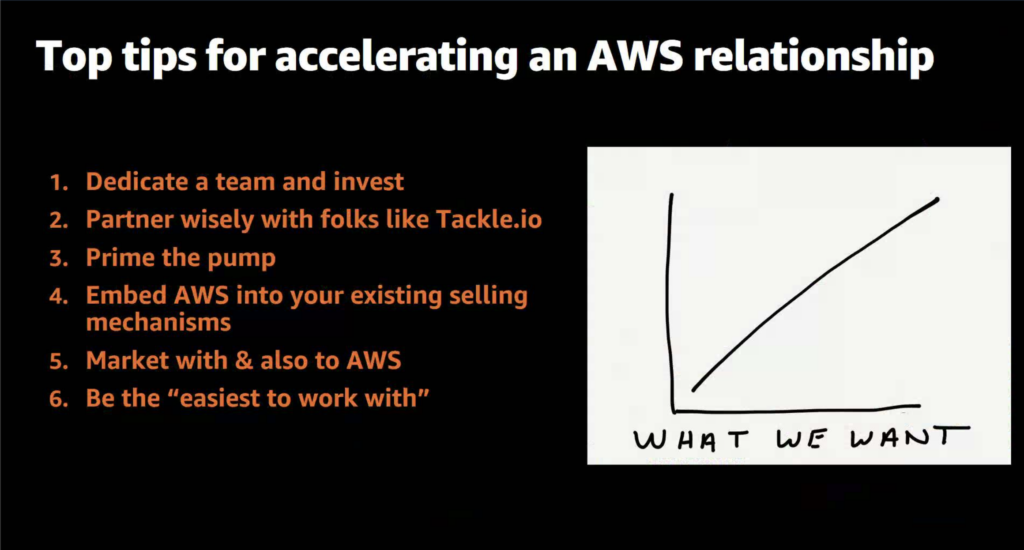
Another big point the AWS Team focused on was co-selling. It is so important that ISVs train their sales team on AWS Marketplace and build around it. What that means is that you want to establish a compensation plan for your field team that incentivizes them to work with AWS. That’s important because you should embed AWS into your selling mechanisms so that the two sides can work seamlessly together. The last bit to remember about co-selling is that it is just as important to market to AWS as it is to market with AWS. If the AWS field team doesn’t understand and know what you do, it’s much harder for them to sell with you. At a high level, those are the keys to success in leveraging the AWS Marketplace.
AWS Product Announcements from re:Invent 2020
Similar to week one of AWS re:Invent, week two saw a deluge of new product and service announcements. There were a total of 18 product announcements between Redshift, SageMaker, Audit Manager, and Lookout. Here are a few we felt were most interesting:
Amazon Redshift
- Amazon Redshift cluster relocation: Move Amazon Redshift clusters between AWS Availability Zones (AZs) without requiring application changes.
- Native console integration (preview): Native integration with select AWS partners from within the Amazon Redshift Console.
Amazon SageMaker
- Amazon SageMaker Data Wrangler: Simplifies the process of data preparation and feature engineering.
- Amazon SageMaker Feature Store: Centralized repository for customers’ machine learning features.
AWS Audit Manager
A new service that helps you continuously audit your AWS usage to simplify how you assess risk and compliance with regulations and industry standards. The service is available globally and offers a Free Tier. Learn more about AWS Audit Manager here.
Amazon Lookout
- Amazon Lookout for Metrics (preview): Detects anomalies in customer metrics to monitor business health, diagnose issues, and find new business opportunities.
Phew, that was quite a bit but we made it. Come back next week for a recap of the last and final week of AWS re:Invent 2020!

